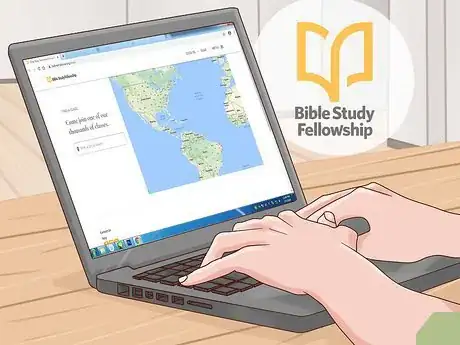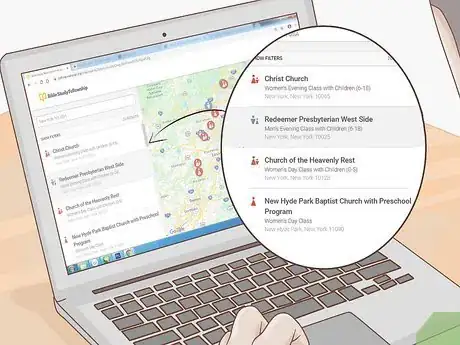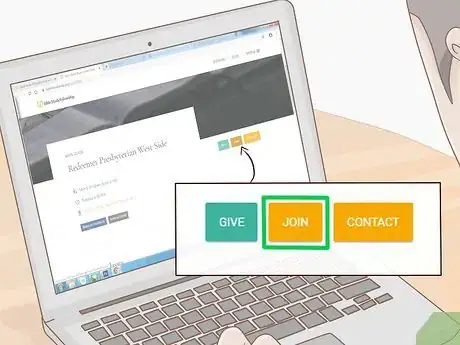This article was co-authored by wikiHow staff writer, Eric McClure. Eric McClure is an editing fellow at wikiHow where he has been editing, researching, and creating content since 2019. A former educator and poet, his work has appeared in Carcinogenic Poetry, Shot Glass Journal, Prairie Margins, and The Rusty Nail. His digital chapbook, The Internet, was also published in TL;DR Magazine. He was the winner of the Paul Carroll award for outstanding achievement in creative writing in 2014, and he was a featured reader at the Poetry Foundation’s Open Door Reading Series in 2015. Eric holds a BA in English from the University of Illinois at Chicago, and an MEd in secondary education from DePaul University.
This article has been viewed 14,506 times.
Learn more...
Bible Study Fellowship (BSF) is a nondenominational Christian organization with over 400,000 members and hundreds of chapters operating in 70 countries.[1] At each independent chapter, members meet weekly to discuss and study the Bible in detail. The goal of joining BSF is to enrich your relationship with God by reading and discussing the Bible with others. While you don’t need to know everything about Christianity to join, it does help to have a solid understanding of key theological issues since BSF meetings can become extremely in-depth. To join Bible Study Fellowship, visit their website and use their search tool to find a chapter near you. Then, enter your personal information and wait for the leader of the chapter to contact you.
Steps
Joining a Chapter near You
-
1Use the search tool to find a BSF chapter near you. Bible Study Fellowship (BSF) uses an online platform to help you find locations and sign up for a group. To start, go online and pull up Bible Study Fellowship’s home page. In the middle of the home page, there is a yellow button that says, “Find a Group Near You.” Click this button to pull up the online search tool.[2]
- You can pull up the search tool directly by visiting https://www.bsfinternational.org/map/.
- The BSF program always starts with a new area of study in September. However, you can join at any point in the year. If you want to join when a new study is beginning, wait until mid-August to sign up.
Tip: There is an online BSF program, but it is currently closed to new applicants. You can check to see when registration reopens by visiting https://bsf.knack.com/virtual-sats#group-selection/.
-
2Enter your city in the search box to find nearby groups. In the search box, enter your city and click the corresponding entry that pops up in the text box underneath. The search tool will retrieve a list of chapters in your area. A corresponding map showing the location of each chapter will pop up on the right.[3]
- In the search box, if you type in your ZIP code, the closest nearby city will pop up in the form underneath the search box.
Advertisement -
3Read the type of class underneath each option to see if you qualify. Bible Study Fellowship chapters are separated into groups for men and groups for women, and you must sign up for a class that matches your biological sex. The requirements for each class are listed underneath the name of the chapter. It also lists the time that the class takes place (evening or day), and whether or not children are allowed to attend. Click a class that matches your gender and time availability to highlight it on the map.[4]
- The chapters are usually named after the church or building where the group meets.
- The ages of children that are allowed to attend are listed in parentheses at the end of each description.
- Any Christian can sign up for Bible Study Fellowship, but you may get a little lost if you haven’t been reading the Bible regularly for a long time. That’s okay, though. The goal of BSF is to read and grow with others, not be the most well-read person in the room.
-
4Click “Go to Class Page” to learn more about a chapter. Once you’ve highlighted a class, click the “Go to Class Page” button at the bottom of the description to go to that specific chapter’s page. This will take you to the a new page with the specific meeting time and the chapter’s address.[5]
- Before signing up for a specific group, copy the address and plug it into an online map to check your commute time. Make sure that a chapter is convenient for you before signing up.
-
5Select the “Join” button to fill out an application for the chapter. On the class’s page, there are 3 buttons on the right side of the page. If you want to sign up for a group, hit the “Join” button to pull up the application. Enter your name, email address, phone number, and the number of children you plan on bringing with you. Hit “Next” to submit your application.[6]
- Choose the “Contact” button instead of the “Join” button if you want to ask any clarifying questions about the group before applying.
- There are no registration fees for joining a BSF chapter. Membership and enrollment are completely free.
-
6Wait for the chapter’s leader to reach out to you via phone or email. The leader will contact you to let you know whether you are accepted or not. If you are accepted, the leader will confirm the group’s meeting time, explain what you need to bring to class, and tell you a little bit about the group. They will also give you your first reading assignment. Complete this reading assignment to prepare for your first class.[7]
- There are class size limitations on BSF chapters, and you may be told that you can’t join due to the size of the class. Typically, chapters are capped at 15 people.
Attending Fellowship Meetings
-
1Show up to your first meeting and introduce yourself to the group. Show up to your first Bible Study Fellowship meeting on time. The leader of the group will introduce you to the rest of the class and may ask you to say a few words about your relationship with God and your experience studying the Bible. Say a few words about yourself and express enthusiasm for studying the Bible with your new group.[8]
- Some chapters have an orientation where you meet with the group, pray together, and introduce yourself before attending the first meeting.
- For example, you may say, “Hello everybody! My name is Melissa and I’ve been a practicing Lutheran for 15 years, but I grew up Catholic. I moved here from New York City about 6 months ago and I am truly excited to grow and worship with you all.”
Tip: Bible Study Fellowship classes are very discussion-based, so don’t feel nervous about sharing with the other members of the group.
-
2Read assigned weekly passages on your own time. Some chapters read passages together as a class, but most chapters assign weekly readings. For example, you may have 1 week to read the first 4 chapters of the Book of Romans. Complete the reading assignment independently and show up to the Fellowship meeting ready to discuss the reading with the group.[9]
- When you read at home, take notes on the content and key passages of the reading so that you can refer to it later. Note any questions you have as you’re reading.
- You may spend up to 8 months reading through a single book of the Bible. The goal of Bible Study Fellowship is to help you to grow closer to God by reading the Bible in-depth and discussing the intricate details as a group.
-
3Discuss the passages you read each week with your group. At each meeting, the leader of the chapter will summarize the key issues and events in the assigned passage. Then, there will be an informal, guided discussion. This discussion is led by the leader of the chapter, but the conversation can develop in a variety of ways. Contribute to the conversation, ask questions, and listen actively to get the most out of your weekly discussions.[10]
- Feel free to disagree with interpretations or points as they’re raised, but be respectful about it. The goal is to gain a deeper understanding of the Bible, not argue with other people!
-
4Develop questions and comments based on issues raised in the reading. As discussions develop, ask yourself, “What does this reading tell me about God or the nature of humanity?” While that question is a big one, identifying the theological relevance of a passage is a great way to determine where the discussion should start. Keep a notebook nearby during meetings so that you can jot down ideas, thoughts, and questions as they come to you.[11]
- You don’t have to speak if you don’t want to. If a particular chapter or passage didn’t really mean a lot to you, there’s no need to force yourself to say something.
- For example, if you’re reading the story of Moses and the burning bush, you may ask, “Why would God take the form of a bush, specifically? Why not a tree or a flower? What does this say about how God shows his love to us?” or something along those lines.
- It’s totally okay to bring up elements of Christian faith as they relate to what you’re reading. For example, a discussion of the Book of Jonah may lead to a discussion surrounding literal and figurative meanings of the Old Testament.
References
- ↑ https://www.bsfinternational.org/
- ↑ https://www.bsfinternational.org/
- ↑ https://www.bsfinternational.org/map/
- ↑ https://www.bsfinternational.org/map/
- ↑ https://www.bsfinternational.org/map/
- ↑ https://www.bsfinternational.org/map/
- ↑ https://www.bsfinternational.org/map/
- ↑ https://youtu.be/Y-lY1R-xo6A?t=36
- ↑ https://youtu.be/Y-lY1R-xo6A?t=147












-Step-9.webp)




















-Step-9.webp)



































